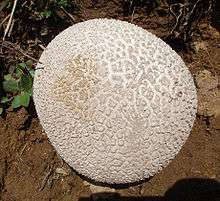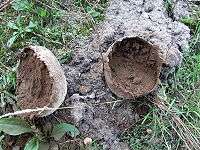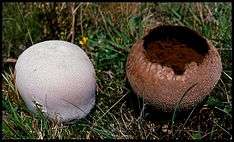Handkea utriformis
Handkea utriformis, synonymous with Lycoperdon utriforme, Lycoperdon caelatum or Calvatia utriformis, is a species of the Lycoperdaceae family of puffballs. A rather large mushroom, it may reach dimensions of up to 25 cm (9.8 in) broad by 20 cm (7.9 in) tall. It is commonly known as the mosaic puffball, a reference to the polygonal-shaped segments the outer surface of the fruiting body develops as it matures. Widespread in northern temperate zones, it is found frequently on pastures and sandy heaths, and is edible when young. H. utriformis has antibiotic activity against a number of bacteria, and can bioaccumulate the trace metals copper and zinc to relatively high concentrations.
Taxonomy
This puffball was originally described in 1790 by French botanist Jean Baptiste François Pierre Bulliard as Lycoperdon utriforme, and since then, has been variously placed in the genera Bovista, Lycoperdon, Calvatia, and Utraria. In 1989, German mycologist Hanns Kreisel described the genus Handkea to include species of Calvatia that had distinct microscopic features: Handkea species have a unique type of capillitium (coarse thick-walled hyphae in the gleba), with curvy slits instead of the usual pores.[1] Although accepted by some authors,[2] the genus concept has been rejected by others.[3]
In the past, the species (when it was known as Calvatia utriformis) has been separated into three varieties (C. utriformis var. utriformis, C. utriformis var. hungarica and C. utriformis var. gruberi) based on differences in the ornamentation of the exoperidium (outer tissue layer of the wall, or peridium) and spores. However, a 1997 study of these characters revealed that the three varieties are not clearly demarcated.[4] This study and others suggest that variations in the environmental conditions in which the specimens are grown can affect the development of these characteristics.[3][5]
Phylogenetic analyses published in 2008 shows that Handkea may be grouped in a clade along with species from several other genera, including Lycoperdon, Vascellum, Morganella, Bovistella, and Calvatia.[6] Published in the same year, another DNA analysis of the structure of ITS2 rDNA transcript confirmed that H. utriformis is closely related to Lycoperdon echinatum.[7]
Description
Like all puffballs, Handkea utriformis has a gasteroid basidiocarp, meaning the spores are produced internally, and are only released as the mature fruiting body ages and dries, or is broken.

Young puffballs are typically 6 to 12 centimetres (2.4 to 4.7 in) across, white, or pale grey-brown;[8] in maturity it may attain dimensions of 25 centimetres (9.8 in) broad by 20 centimetres (7.9 in) tall.[9] The exoperidum is tomentose—desely covered with a layer of fine matted hairs. The species derives its common name "mosiac puffball" from the mosaic pattern across the top and sides that develops as the fruiting body matures and the outer wall (exoperidium) breaks up into polygonal patches.[10] The underside of the puffball is attached to the ground by a root-like assemblage of hyphae called a rhizomorph.[11] It is squat in appearance and roughly pear-shaped, not usually taller than it is wide. The flesh (gleba, or spore bearing mass) is white when young, but becomes brown and powdery upon maturity. The upper skin eventually disintegrates weeks or even months after the puffball's appearance, and the brown spores are released into the air; this process is often hastened by rain, or by being trodden on by cattle. Eventually, all that remains is the sterile cup-shaped base, which can sometimes hold water. This feature may have been the source of the specific epithet, as utrarius is Latin for ‘water carrier’.[12]
Microscopic features
The spores of H. utriformis are roughly spherical, smooth, and thick-walled, with a single oil droplet. They have dimensions of 4.5–5.5 µm.[9]
Similar species
A number of puffball species resemble H. utriformis, including Calvatia cyathiformiss, C. booniana, and C. pachyderma. Calvatia cyathiformis has a purple-colored gleba with a smooth exoperidium; C. booniana has an exoperidium that resembles felt or has tufts of soft "hairs" like H. utriformis but does not have any stem and has a capillitium with rounded rather than sinuous pits; C. pachyderma has an exoperidium that is thicker and smoother than H. utriformis.[9]
Distribution and habitat
Handkea utriformis is widespread, and frequent in northern temperate zones.[13] It is found in Europe, continental Asia, Japan, eastern atlantic North America, Mexico, and South Africa.[14] It has also been collected in Chile,[15] and New Zealand.[16] Growing alone or in small groups, it favors sandy open pastures, or heaths, and is often found in coastal regions. It typically fruits in summer through late autumn[8][13] (July - November in the UK).
Edibility

This fairly large puffball is edible only when the spore bearing flesh is young, and white.[8] It is said to lack texture, and the taste and odor of the young fruiting bodies are described as "not distinctive".[9] A 2007 study of the fatty acid composition of various edible Lycoperdaceae species determined the lipid content of H. utriformis to be quite low, approximately 1.8% (wet weight). The fatty acid content was largely linoleic acid (42.4%), oleic acid (23%), palmitic acid (12.2%), and stearic acid (3.6%); 17 other fatty acids of various chain lengths and degrees of unsaturation contributed to the total fatty acid composition.[17]
Antibiotic activity
A 2005 study of the antimicrobial activity of several Lycoperdaceae revealed that Handkea utriformis has "significantly active" against a number of bacteria, including Bacillus subtilis, Escherichia coli, Klebsiella pneumonia, Pseudomonas aeruginosa, Salmonella typhimurium, Staphylococcus aureus, Streptococcus pyogenes, and Mycobacterium smegmatis. On the other hand, H. utriformis has low antifungal activity against the species Candida albicans, Rhodotorula rubra, and Kluyveromyces fragilis.[18]
Bioaccumulation
A study of the copper and zinc concentrations in 28 different species of edible mushroom showed that H. utriformis selectively bioaccumulated both copper (251.9 mg of copper per kilogram of mushroom) and zinc (282.1 mg Zn/kg mushroom) to higher levels than all other mushrooms tested.[19] The authors note that although these trace elements are important nutritional requirements for humans, and that H. utriformis may be considered a good source of these elements, it is known that absorption of the elements (bioavailability) from mushrooms is "low due to limited absorption from the small intestine".[20]
References
- ↑ Kreisel H (1989). "Studies in the Calvatia complex (basidiomycetes)". Nova Hegwigia. 48 (3–4): 281–96.
- ↑ Laessøe T, Pegler DN, Spooner B (1995). British puffballs, earthstars and stinkhorns: an account of the British gasteroid fungi. Kew: Royal Botanic Gardens. ISBN 0-947643-81-8.
- 1 2 Demoulin V, Lange M (1990). "Calvatia turneri (Ellis et Everh.) Demoulin et M. Lange, comb. nov., the correct name for C. tatrensis Hollós". Mycotaxon. 38: 221–26.
- ↑ Martin MP. "Exoperidium and spores of Calvatia utriformis". Mycotaxon. 61: 381–87.
- ↑ Demoulin V. (1971). "Le genre Lycoperdon en Europe et en Amérique du Nord. Etude taxonomique et phytogéographique". PhD. thesis, Université de Liège.
- ↑ Larsson E, Jeppson M (2008). "Phylogenetic relationships among species and genera of Lycoperdaceae based on ITS and LSU sequence data from north European taxa". Mycological Research. 112 (Pt 1): 4–22. doi:10.1016/j.mycres.2007.10.018. PMID 18207380. Retrieved 2009-04-01.
- ↑ Krüger D, Gargas A (2008). "Secondary structure of ITS2 rRNA provides taxonomic characters for systematic studies—a case in Lycoperdaceae (Basidiomycota)". Mycological Research. 112 (Pt 3): 316–30. doi:10.1016/j.mycres.2007.10.019. PMID 18342242.
- 1 2 3 Phillips R (2006). Mushrooms. Pan MacMillan. ISBN 0-330-44237-6.
- 1 2 3 4 "California Fungi: Handkea utriformis". Retrieved 2009-04-01.
- ↑ Ellis JB, Ellis MB (1990). Fungi without Gills (Hymenomycetes and Gasteromycetes): an Identification Handbook. London: Chapman and Hall. p. 224. ISBN 0-412-36970-2.
- ↑ Agerer (2002). "Rhizomorph structures confirm the relationship between Lycoperdales and Agaricaceae (Hymenomycetes, Basidiomycota)". Nova Hedwigia. 75 (3–4): 367–85. doi:10.1127/0029-5035/2002/0075-0367.
- ↑ "Latin Dictionary Definition and Information for: utrarius, utrari(i) - LATdict Latin Dictionary and Resources". Archived from the original on July 23, 2011. Retrieved 2009-06-19.
- 1 2 Laessoe T (1998). Mushrooms (flexi bound). Dorling Kindersley. ISBN 0-7513-1070-0.
- ↑ Bottomley AM (1948). "The Gasteromycetes of South Africa". Bothalia. 4: 473–810.
- ↑ Kreisel H, Moreno G (1996). "The genus Handkea Kreisel (Basidiomycetes, Lycoperdaceae) in the southern hemisphere". Feddes Repertorium. 107 (1–2): 83–87. doi:10.1002/fedr.19961070111.
- ↑ Cunningham GH (1944). The Gasteromycetes of Australia and New Zealand. Dunedin, New Zealand.
- ↑ Nedelcheva D, Antonova D, Tsvetkova S, Marekov I, Momchilova S, Nikolova-Damyanova B, Gyosheva M (2007). "TLC and GC-MS probes into the fatty acid composition of some Lycoperdaceae mushrooms". Journal of Liquid Chromatography & Related Technologies. 30: 2717–27. doi:10.1080/10826070701560629.
- ↑ Dulger B (2005). "Antimicrobial activity of ten Lycoperdaceae". Fitoterapia. 76 (34): 352–54. doi:10.1016/j.fitote.2005.02.004. PMID 15890468.
- ↑ Alonso J, García MA, Pérez-López M, Melgar MJ (2003). "The concentrations and bioconcentration factors of copper and zinc in edible mushrooms". Archives of Environmental Contamination and Toxicology. 44 (2): 180–88. doi:10.1007/s00244-002-2051-0. PMID 12520390.
- ↑ The authors (Alonso et al., 2003) cite from Kalač P, Nižnanská M, Bevilaqua D, Štašková I. (1996). "Concentrations of mercury, copper, cadmium and lead in fruiting bodies of edible mushrooms in the vicinity of a mercury smelter and a copper smelter". Science of the Total Environment 177: 251–58.
External links
- Handkea utriformis in MycoBank.
- H. utriformis in Index Fungorum
- Mycobank
- Medicinal Mushrooms Medicinal properties and bioactive compounds
